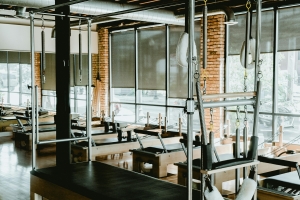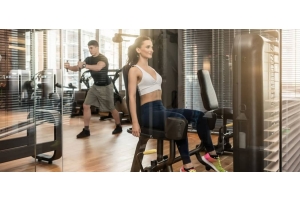Compound Exercises for Back, Abs and Arms

Want to work multiple muscle groups and save time doing it? Compound strength exercises encompass total body training by using a single exercise - think deadlifts, where you build a stronger back, arms, core and legs in one exercise.
Using total body training exercises can also help to prevent injury. Provided you start out at a weight that is suitable, exercises like the deadlift, if performed with good form, can help to strengthen the lower back without placing undue stress on that specific area.
What Are Compound Exercises?
Quite simply, exercises that work multiple muscle groups at the same time! Now that either means a single exercise that does the job, or you can also combine two exercises into one move in order to create a unique compound exercise. An example of each compound would be squats or a bodyweight squat with a bicep curl.
The squat, when done properly, would exercise your quadriceps, glutes and calves with one exercise.
As you can see, there's a huge advantage there over isolated exercises like bicep curls or leg extensions. There's nothing wrong with isolated exercises, as they can be great to focus on one muscle, or if you have to do rehab, they can ensure you are properly targeting the muscle in question.
What Benefits Are There?
Apart from the benefit of being quick and easy to perform, there are other benefits that we list below. People with limited time to workout should be doing lots of compound exercises to build strength and muscles.
- You will burn more calories
- Elevates your heart rate
- Improves your strength
- Gains in muscle mass
- Improves your coordination
- Improves your flexibility
5 Compound Exercises
1. Deadlift
Equipment you need: barbell (and plates if you are stronger)
Targeted muscles: forearms, lats, glutes, hamstrings, core, upper back, mid back and lower back
2. Reverse lunge to balance with bicep curl
Equipment you need: set of dumbbells
Targeted muscles: glutes, hamstrings, abs, hips, biceps
3. Squat (Bodyweight)
Equipment you need: none
Targeted muscles: quadriceps, glutes, and calves
4. Front Lunge (with twist)
Equipment you need : none
Targets muscles : glutes, hamstrings, abs, hips
5. Dumbbell Shoulder Press On Ball
Equipment you need : Dumbbells and an exercise ball
Targets muscles : abs, deltoids, pectoralis major, triceps brachii
Workout Schedule
So let's assume users are going to the gym 3 or 4 times a week - we'd suggest that if you are healthy and into the gym, you should be able to safely incorporate compound exercises into your work schedule 2 or 3 times a week with no problems. You may have some aches and pains the first couple of weeks as your body gets used to the more intense exercising, but you should be fine if you keep the weight sensible to start with.
Do not train on successive days, i.e. leave a day between. It is entirely your choice whether you want to do multiple muscle groups each day, or focus more on the upper body one day, lower body the next and effectively alternate what you're doing.
With compound, there's also an advantage of using the "in-between" days for cardio work - whether in the gym, out on the bike, or a gentle run. This will help to up your fitness whilst also burning fat and increasing your heart rate. This is a great way to do it and mixes up your week nicely. Think swimming, running, rowing, climbing, steps, dance classes or spin classes for starters - maybe even a more cardio-based CrossFit session?
Compound Exercise Safety
Ok, so compound exercises will not be for everyone. Exercises like deadlifts require you to be able to keep your form and to safely perform each rep in order to prevent injury. Perfecting each exercise is relatively straightforward, especially if you get the chance to work with a PT or a gym trainer. They will help check you at each stage and will also watch that you are not adding too much weight too soon.
As an absolute beginner, we'd definitely recommend some help, as you cannot simply watch a YouTube or TikTok video and transfer that knowledge over and perform 100% correctly. It is not worth the risk for you or your body. Another way to help with that is to have a workout buddy who knows what they are doing - they can help spot you in the first few weeks as you build up your strength and technique.
Start with a light weight that seems too easy, perform 10 - 12 reps before you take a break. Then repeat twice (three sets of 10 - 12 reps in total).
Do NOT be tempted to up the weight because it feels too easy. When you are 100% stable and comfortable after a few sessions, your form is good and you feel ready, then increase the weight for the second and third set. This should then start to create a "burn" as you get towards the end of each set of reps.
In Summary
Compound exercises are an efficient and effective way to maximise your time in the gym. Try to mix up your workout routine every few weeks and add new compound exercises.
The variety will help you work more muscle groups, prevent plateauing, and prevent boredom.
If you aren’t sure how to properly perform a compound exercise, ask a trainer or fitness professional at your gym. They can show you the right technique so you avoid injury.
Before starting a new exercise routine, see your doctor. They can recommend a safe workout schedule for your fitness level.





